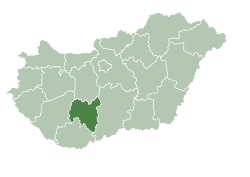Jágónak
In this article, we will delve into the fascinating world of Jágónak. From its origins to its relevance today, we will explore all aspects related to this topic. We will analyze its impact on society, its implications in different areas and the challenges it poses. Additionally, we will examine the latest trends, discoveries, and milestone advances in Jágónak. Through this journey, we aim to provide a comprehensive and updated vision of Jágónak, in order to enrich our knowledge and understanding of this exciting topic.
Jágónak | |
|---|---|
Village | |
 View of the village from the southeast | |
 Location of Tolna county in Hungary | |
| Coordinates: 46°18′49″N 18°05′33″E / 46.31361°N 18.09250°E | |
| Country | |
| County | Tolna |
| Area | |
• Total | 15.4 km2 (5.9 sq mi) |
| Population (2011) | |
• Total | 239 |
| • Density | 16/km2 (40/sq mi) |
| Time zone | UTC+1 (CET) |
| • Summer (DST) | UTC+2 (CEST) |
| Postal code | 7357 |
| Area code | 74 |
Jágónak is a village in Tolna county, Hungary.
History
In the second half of the 18th century, Swabians arrived in the village. Following the Second World War, the village's German population was deported, and replaced with Hungarians from Slovakia. This resettlment was coordinated by the Czechoslovak–Hungarian population exchange program.
In 1975, the village was transferred from Baranya County to Tolna County.
Demographics
As of 2011, the village was 84.9% Hungarian, 3.8% German, and 1.3% Gypsy. The villagers are 62.6% Roman Catholic, and 3.4% Reformed.[1]
References
- ^ "Magyarország helységnévtára". www.ksh.hu. Retrieved 2024-06-01.



